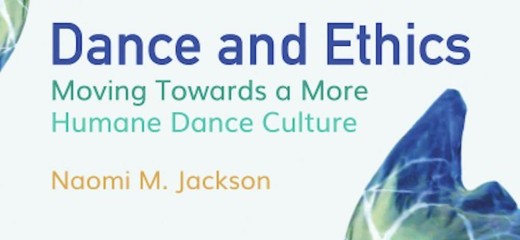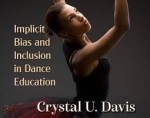
Dialoguing Ethics in Dance
by Leila Mire
It is often taken for granted that dance, a field that proclaims to celebrate humanity, places ethics at the forefront of its practice. And yet, I would be in the minority to confess that, in my experience, ethics are seldom regarded with the reverence it religiously anoints itself with. In fact, as institutions address unfair work practices, sexual harassment allegations come forth, and artists take to social media regarding workplace abuse, it becomes clear that ethical treatment in dance is an exception, not a norm.
It is in this realm that dance scholar Naomi Jackson aims to intervene with her latest book, Dance and Ethics: Moving Towards a More Humane Dance Culture. Organizing her book based on what she perceives to be the normative track for a concert dancer (i.e., the dancer begins as a student, followed by an educator, choreographer, and programmer) she traces the field’s history, addressing issues that arise in education and dance institutions.
Beyond explaining the book’s structure and introducing her positionality as a white, secular, Jewish dance scholar, chapters 1 and 2 effectively break down academic definitions of ethics, clarifying where tensions arise when placed alongside dance. These interventions can take various forms, including care ethics, somatics, and community dance.
In the two chapters that follow, Jackson turns her attention to the dynamics between educators, choreographers, and dancers. Among these relationships, she is particularly drawn to the asymmetrical power dynamic embedded in the choreographic genius archetype, tracing it from the Romantic Era of ballet and its infantilization of female dancers to present-day contemporary dance. Through process-oriented work, choreographic oversight, and a more egalitarian organizational structure, Jackson asserts that such abuses of power can be mitigated.
At this point, she departs from the dancer and choreographer as primary focal points and moves into the history and trajectory of dance criticism. Arguing against its fault-finding tendencies, she draws on case studies like Liz Lerman’s Critical Response Process to champion more dialogic critique and productive feedback. This seamlessly segues into the book’s final section, a critique of how money and power materialize through dance, followed by a solution, one that incorporates organizational justice and pre-existing business models for a fair workplace.
The book, although interesting in concept, lacks the critical dialogue needed to be transformative in the field. Though I am drawn to the book’s topic and introduction, its claim toward an in-depth analysis of ethics in dance seems to come second to innocuous, well-defined ethical transgressions (i.e., choreographers hitting dancers is bad, choreographers being respectful is good). Despite its aim to inspire fundamental change in the field, it relies heavily on the status quo, one meant to be broken.
For instance, while advocating for more diverse voices, Jackson turns to the most written-about faces in dance history (i.e., George Balanchine, Serge Diaghilev, and Martha Graham). Though focusing on concert dance, her inclusion of outlying examples is transparent enough to reveal that they are used for the sake of the argument and not for their relationship to the issues at hand (for example, popping in an occasional case study outside of “concert dance” to satisfy calls for diversity and superficially appeal to a broader audience).
This comes at several costs to the book’s integrity, the greatest of which weakens the book’s central argument. On the one hand, it dilutes the book’s structure, and on the other, it thrusts a normative dance career onto the reader, giving audiences false impressions of what the field looks like. The fundamental shortcoming revealed in this logic is repeated throughout the book, exposing that beneath the surface of radicalism lies unwavering neoliberalism. This point is further made reticent through the great trust she places in institutions, all the while failing to acknowledge their white, exploitative histories and the uninterrupted harm they continue to cause. It is worth following the “money trail,” so to speak, noting that her unwavering support of Israel is reflected by the funding she received from the Lincoln Center for Applied Ethics to write this book, an institution and founder known for their Zionist alignment. As such, I would argue that a certain unregarded ethical bias deserves mention while speaking about the politicism of ethics.
Despite these grievances, the book is not without its strengths. Several points regarding ballet culture and the infantilization of the female dancer are worthwhile. I am impressed by its analysis of ballet history and how people’s perceptions of how it has changed over time. This considered, the book is best suited for ballet dancers and educators. Furthermore, I find it admirable that Jackson took on such an ambitious and worthwhile subject matter. While there were moments where I found myself at a pause, I am reminded that ethics is a continuous dialogue, one that insists we pause, listen, and reflect, learning from what we are, who we are not, and what limitations we have.
Naomi Jackson, Dance, and Ethics: Moving Towards a More Humane Dance Culture. Bristol, United Kingdom, Intellect Books, 2022.
By Leila Mire
September 25, 2023










